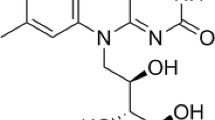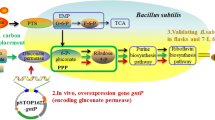Abstract
Objectives
To construct an Escherichia coli strain capable of producing riboflavin with high titer and yield.
Results
A low copy number plasmid pLS01 containing a riboflavin operon under the control of a constitutive promoter was constructed and introduced into Escherichia coli MG1655. Subsequently, the pfkA, edd and ead genes were disrupted, and the resulting strain LS02T produced 667 mg riboflavin/l in MSY medium supplied with 10 g glucose/l in flask cultivation. In a fed-batch process, riboflavin production of the strain reached 10.4 g/l with a yield of 56.8 mg riboflavin/g glucose.
Conclusion
To our knowledge, this is the first report of engineered E. coli strains that can produce more than 10 g riboflavin/l in fed-batch cultivation, indicating that E. coli has potential for riboflavin production.




Similar content being viewed by others
References
Buey RM, Ledesma-Amaro R, Balsera M, de Pereda JM, Revuelta JL (2015) Increased riboflavin production by manipulation of inosine 5′-monophosphate dehydrogenase in Ashbya gossypii. Appl Microbiol Biotechnol 99:9577–9589
Dmytruk K, Lyzak O, Yatsyshyn V, Kluz M, Sibirny V, Puchalski C, Sibirny A (2014) Construction and fed-batch cultivation of Candida famata with enhanced riboflavin production. J Biotechnol 172:11–17
Duan YX, Chen T, Chen X, Zhao XM (2010) Overexpression of glucose-6-phosphate dehydrogenase enhances riboflavin production in Bacillus subtilis. Appl Microbiol Biotechnol 85:1907–1914
Kotlarz D, Garreau H, Buc H (1975) Regulation of the amount and of the activity of phosphofructokinases and pyruvate kinases in Escherichia coli. Biochim Biophys Acta 381:257–268
Kuhlman TE, Cox EC (2010) Site-specific chromosomal integration of large synthetic constructs. Nucleic Acid Res 38:e92. doi:10.1093/nar/gkp1193
Lin Z, Xu Z, Li Y, Wang Z, Chen T, Zhao X (2014) Metabolic engineering of Escherichia coli for the production of riboflavin. Microb Cell Factor 13:104. doi:10.1186/s12934-014-0104-5
Mack M, van Loon AP, Hohmann H-P (1998) Regulation of riboflavin biosynthesis in Bacillus subtilis affected by the activity of the flavokinase/flavin adenine dinucleotide synthetase encoded byribC. J Bacteriol 180:950–955
Marx H, Mattanovich D, Sauer M (2008) Overexpression of the riboflavin biosynthetic pathway in Pichia pastoris. Microb Cell Factor 7:23. doi:10.1186/1475-2859-7-23
Qiu YZ, Han J, Guo JJ, Chen GQ (2005) Production of poly(3-hydroxybutyrate-co-3-hydroxyhexanoate) from gluconate and glucose by recombinant Aeromonas hydrophila and Pseudomonas putida. Biotechnol Lett 27:1381–1386
Shi S, Shen Z, Chen X, Chen T, Zhao X (2009) Increased production of riboflavin by metabolic engineering of the purine pathway in Bacillus subtilis. Biochem Eng J 46:28–33
Sohoni SV, Nelapati D, Sathe S, Javadekar-Subhedar V, Gaikaiwari RP, Wangikar PP (2015) Optimization of high cell density fermentation process for recombinant nitrilase production in E. coli. Bioresour Technol 188:202–208
Stahmann KP, Revuelta JL, Seulberger H (2000) Three biotechnical processes using Ashbya gossypii, Candida famata, or Bacillus subtilis compete with chemical riboflavin production. Appl Microbiol Biotechnol 53:509–516
Wang Z, Chen T, Ma X, Shen Z, Zhao X (2011) Enhancement of riboflavin production with Bacillus subtilis by expression and site-directed mutagenesis of zwf and gnd gene from Corynebacterium glutamicum. Bioresour Technol 102:3934–3940
Wang G, Bai L, Wang Z, Shi T, Chen T, Zhao X (2014) Enhancement of riboflavin production by deregulating gluconeogenesis in Bacillus subtilis. World J Microbiol Biotechnol 30:1893–1900
Xu Z, Lin Z, Wang Z, Chen T (2015) Improvement of the riboflavin production by engineering the precursor biosynthesis pathways in Escherichia coli. Chin J Chem Eng 23:1834–1839
Acknowledgments
The authors thank Dr. Thomas E. Kuhlman and Dr. Zhenquan Lin for kindly providing some of the plasmids used in this study. This work was supported by the National 973 Project (2012CB725203), and National High-tech R&D Program of China (2012AA022103, 2012AA02A702).
Supporting information
Supplementary Table 1—Primers used in this study.
Supplementary Figure 1—pLS01 map.
Supplementary Figure 2—Time profiles of cell growth, glucose consumption and riboflavin production of LS02T cultivated in LBG, M9 and MS media.
Author information
Authors and Affiliations
Corresponding author
Electronic supplementary material
Below is the link to the electronic supplementary material.
Rights and permissions
About this article
Cite this article
Liu, S., Kang, P., Cui, Z. et al. Increased riboflavin production by knockout of 6-phosphofructokinase I and blocking the Entner–Doudoroff pathway in Escherichia coli . Biotechnol Lett 38, 1307–1314 (2016). https://doi.org/10.1007/s10529-016-2104-5
Received:
Accepted:
Published:
Issue Date:
DOI: https://doi.org/10.1007/s10529-016-2104-5




